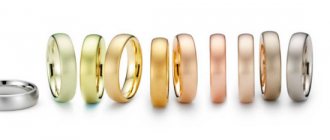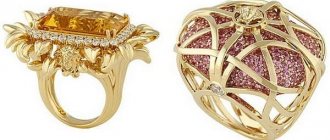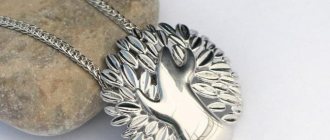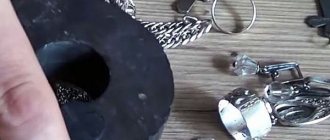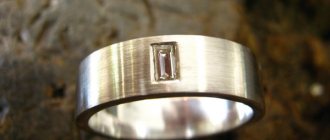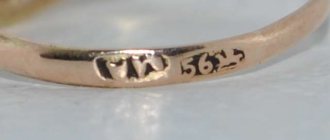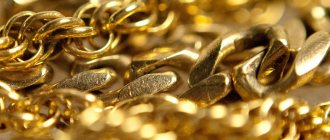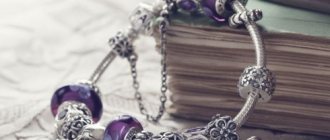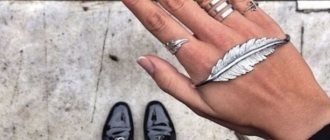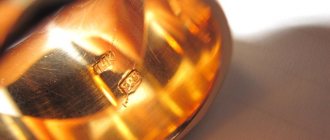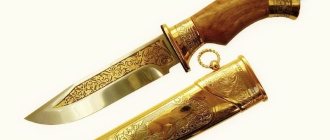What is
Rhodium is a noble metal, a platinoid. 45th element of the Mendeleev periodic table.
Rhodium is the most expensive and hardest of the platinoids.
Rhodium looks different:
- Connections – pink, red. Therefore, the new element was called rhodium - in ancient Greek “rose”.
- The metal is bluish-silver, with a cold aristocratic shine.
- The powder is gray to black.
The international designation is Rhodium (Rh).
History of discovery
Initially, the metal was considered a waste product, a by-product of platinum production.
The first to become interested in it was in 1803 the British chemist William Wollaston.
He examined platinum from the mines of South America, performing a series of experiments:
- After dissolving the samples with aqua regia, the liquid turned pink-reddish.
- When platinum and palladium precipitated, a purplish powder formed.
- It was fried in hydrogen.
The result was a massive grayish powder.
Medicine lost, but chemistry gained
I didn’t think about chemistry, I studied at Oxford, trained as a doctor, and wanted to work at St. George’s Hospital. However, the young doctor was refused, and another was hired. Offended, Wollaston spat on medicine and took up chemistry and physics. It is unknown what medicine has lost, but humanity should be grateful to the scientist for his work with platinum group metals.
Wollaston's work in chemistry is highly appreciated by scientists. We are interested in rhodium. Wollaston is the “father” of rhodium, like palladium. Moreover, Wollaston was not just a scientific cracker, but undoubtedly had a sense of humor. The history of people's acquaintance with palladium is described in more detail in the article on palladium.
Rhodium remained in the shadow of palladium, but in vain. The scientist isolated the metal while working with native platinum, and its composition included palladium, rhodium and other platinum group metals.
Rhodium, a silvery, white-bluish metal, got its name from the ancient Greek word ῥόδον, rose. The metal is white, and the rhodium salts are deep red. Dissolve rhodium in aqua regia and see for yourself.
Rhodium in nature
Rhodium is classified as a rare element.
The mass fraction of rhodium in the bowels of the planet is one millionth of a percent. Meteorites are almost 500 times richer.
Pure rhodium ore does not exist; the element is represented by other types:
- Component of platinum ores, gold-bearing sands.
- Element of osmiridium minerals in copper-nickel deposits.
- Native Nevyanskite. The most generous mineral for rhodium (more than 10%).
The independent mineral Rhodium has not been found; it always acts as a companion.
Black rhodium plating
The use of black rhodium plating is considered quite unusual. Many jewelers use black rhodium to add an aged look to jewelry or stones to add brightness and originality to modern vintage-inspired pieces.
The color of the metal, and therefore the coating, is affected by a component such as a saline solution. It is this that determines the final color of the rhodium plating and the shade of the ring, chain, pendant, etc.
When buying jewelry, you need to check whether it contains rhodium plating. Although this increases the cost, it will be protected and last much longer.
Physico-chemical characteristics
Rhodium compounds are more resistant to mechanical, chemical stress, and corrosion than platinum or gold:
- Mechanical processing is only possible at 810-900°C.
- Hot aqua regia and strong sulfuric acid can only dissolve powder fractions, and not immediately.
- It can be alloyed without problems with metals (especially platinum group metals).
In air, rhodium oxidizes in the range of 600-800°C. At levels above 800°C, the oxide film disappears from the surface.
| Properties of the atom | |
| Name, symbol, number | Rhodium (Rh), 45 |
| Atomic mass (molar mass) | 102.90550(2) a. e.m. (g/mol) |
| Electronic configuration | [Kr] 4d8 5s1 |
| Atomic radius | 134 pm |
| Chemical properties | |
| Covalent radius | 125 pm |
| Ion radius | (+3e)68 pm |
| Electronegativity | 2.28 (Pauling scale) |
| Electrode potential | +0.8v |
| Oxidation states | 5, 4, 3, 2, 1, 0 |
| Ionization energy (first electron) | 719.5 (7.46) kJ/mol (eV) |
| Thermodynamic properties of a simple substance | |
| Density (at normal conditions) | 12.41 g/cm³ |
| Melting temperature | 1963°C |
| Boiling temperature | 3727°C |
| Ud. heat of fusion | 21.8 kJ/mol |
| Ud. heat of vaporization | 494 kJ/mol |
| Molar heat capacity | 24.95 J/(K mol) |
| Molar volume | 8.3 cm³/mol |
| Crystal lattice of a simple substance | |
| Lattice structure | cubic face-centered |
| Lattice parameters | a=3.803 Å |
| Debye temperature | 480K |
| Other characteristics | |
| Thermal conductivity | (300 K) 150 W/(m K) |
| CAS number | 7440-16-6 |
Natural Rhodium has no formula because it consists only of the 103Rh isotope.
Application process
To plate a piece of jewelry with rhodium, it must first be prepared. The jewelry is polished until all traces of its use disappear. After this, the product must be washed and degreased, and only then placed in a galvanic bath, where the rhodium plating process itself takes place.
A special solution containing positively charged particles of metal salts is first poured into the prepared container. The product itself is negatively charged before immersion. After it is placed in a liquid, an electric charge is passed through it, which provokes the attraction of different particles to each other. The decoration, which is an anode, should completely disappear under the rhodium layer under the influence of current. Depending on the exposure time and intensity of the electric charge, the thickness of the coating layer changes.
Previously, rhodium salts were the main element in this process, but since it is extremely difficult to extract them, over time the substance was successfully replaced by rhodium sulfate in a concentrated solution. It is produced specially for covering jewelry in sufficient quantity.
Deposits, extraction methods
Until the beginning of the third millennium, the “custodian” of most ore reserves was Russia with gigantic deposits of native platinum in the Urals and the Arctic.
Today, Mexico holds the lead in reserves (43%), whose golden sands are oversaturated with rhodium. Next come the deposits of South Africa, Colombia, and the USA.
The annual global production of rhodium does not exceed 31 tons.
The number one metal exporter (80% of volumes) is South Africa.
Rhodium is mined on an industrial scale using a closed (mine) method. It is complicated by the composition of the ore: the metal is mixed with gold, palladium, platinum and silver.
Disadvantages of coverage
The main disadvantage of this metal is its fragility, which does not allow its use directly in the manufacture of jewelry. Of course, even if we do not take this fact into account, products from rhodium are not made due to its high cost, which exceeds the price of gold tens of times. Just to cover a ring or chain with rhodium, you will need to pay an average of 500-1000 rubles, and not every workshop can provide such a service.
After repair, a rhodium-plated product most often requires re-coating, since the top layer of metal can peel off under mechanical stress.
It should also be taken into account that the coating is applied very thinly, which means that over time with regular use it can simply wear off. On average, rings, bracelets and chains can retain their original characteristics for five years; for earrings this period is already about 10 years.
Receiving technology
Obtaining pure metal is a complex multi-step process.
Traditional method
Involves refining platinum ore and extracting the Rhodium component.
Raw materials are transported from the deposit to the processing complex.
Here the precious components and the “empty” are separated:
- The ore is crushed and filled with water and chemical components.
- The mixture is saturated with air under pressure.
- The foam floats up, capturing platinum particles.
- It is removed and sent to dry.
The platinum content reaches 110-990 grams per ton.
The next stage is metallurgy. The concentrated mixture is immersed in ovens and heated to 1500°C. The waste rock is burned and the slag is removed by blowing. The metal content increases to 1400 g per ton.
The final stage is refining. It allows you to isolate other elements from platinum.
The solution left over from the platinum purification process is used to release the rhodium. After exposure to chemical components and calcination, almost pure metallic rhodium is obtained.
The journey from transporting ore from the deposit to obtaining pure rhodium takes five to six months.
From nuclear waste
A technology for producing rhodium from waste from nuclear power plants is being developed. This solves several problems: an increase in the amount of rare metal (there may be more of it in spent nuclear fuel than on the entire planet) plus the environment.
Isn't this dangerous?
To ensure good adhesion and high-quality structure of the precious metal in the coating, it is important to carry out the correct chemical treatment of the surface. If necessary, gross defects are removed on a polishing machine.
If the sequence is not followed or one of the preparation stages is skipped, there is no guarantee of obtaining high-quality sediment. Removing low-quality coating is difficult, it requires additional time and entails additional costs.
Despite the many chemicals used in processing, coated products are completely safe to use. After rhodium plating, no traces of electrolyte remain on the surface of the parts.
Where is it used?
The metal, despite its exorbitant price, is in demand in larger volumes than is mined.
Rhodium foil and wire
Industry
Its properties have ensured the use of rhodium alloys by the industrial complex, especially in catalysts:
- Iridium or platinum contain instruments for determining temperatures of about 2200°C.
- Only on platinum-rhodium filters do some crystals grow in laboratories.
- Platinum alloy reduces the nitric acid production cycle.
- They are used to make car exhaust neutralizers.
The automobile industry is the main consumer of rhodium.
- The number two consumer of metal is glass production. Glass melts are melted in rhodium-platinum vessels to produce the finest threads.
- They cover the surface of mirrors of ultra-precise instruments. All thanks to the fact that the metal surface reflects 80% of the light of the visible part of the spectrum and does not dim from super heat.
Radio engineering does not use it as a basis for the manufacture of parts - it is too fragile and brittle. In radio components (including Soviet equipment) this is only a coating. For example, the contacts (reed relays) of RES 55(A) are coated with rhodium.
Material of a new era
Metallic rhodium is used as a component of the material for mirrors of laser systems and diffraction gratings of spectrometers.
Rhodium detectors are used in devices that measure neutron flux.
Electronics is becoming an important area of application. Filters for LCD monitors (TVs, laptops, iPhones, and other gadgets) are made of metal.
Jewelry
In the jewelry and watch segment, metal is the partner of gold, platinum, and silver.
Jewelers appreciated rhodium plating. This is a procedure for coating the surface of jewelry with the thinnest (0.11-0.26 microns) layer of rhodium.
Rhodium plating of jewelry
Rhodium plating is thinner than a human hair, but works wonders:
- Silver treated with rhodium begins to shine and becomes stronger. Does not fade or darken in air.
- Platinum becomes stronger and gains shine.
- The surface of ordinary gold acquires an elite platinum shine. The product becomes more wear-resistant.
The benefits don't end there. Thanks to rhodium, it became possible to create snow-white gold for aesthetes and black gold for fans of the avant-garde.
Rhodium plating improves the aesthetic and utilitarian characteristics of jewelry.
The disadvantages are not critical:
- Cleaning with abrasives, which damage the layer, is prohibited.
- After repair, the decoration needs to be coated with a new layer.
The lifespan of coatings in jewelry is determined by the thickness and intensity of use. In practice, this is five to seven, with careful treatment - tens of years.
Rhodium plated ring
Application of metal
Rhodium is an “arrogant” metal; it does not react with most compounds and elements. Its sustainability creates demand for it in various industries. One thing that stops us is the price. However, the metal is used in the chemical and glass industries.
We recommend: URANIUM - a metal for peace and war
Catalyst grids are used to produce nitric acid. Although rhodium in the alloy of these meshes is only 5-7%, this amount is sufficient to significantly increase the strength of the mesh and the loss of platinum during operation.
The use of rhodium is growing every year. The physical properties of the element are indispensable in the automotive industry. High reflectivity means that car headlights are successfully coated with rhodium. Car exhaust catalysts are more fun and work much better with rhodium catalysts.
Acetic acid is obtained from methylene; rhodium catalysts are indispensable here.
Liquid crystal screens (our expensive monitors and televisions) cannot do without a platinum-rhodium alloy - and we can no longer do without televisions and computers.
For your information: there is an opinion that elements made of pure rhodium were used in Soviet radio components. It is a myth. But metal was used as a coating for contacts.
For us, loved ones
Rhodium plating is used for items made of silver and white gold.
Silver is prone to oxidation; over time, jewelry darkens, and not everyone likes this. Rhodium plating gives the silver product the whiteness of mountain snow and a bright shine.
A person who is good at distinguishing shades of colors will notice that “white gold” is not absolutely white. It has barely distinguishable pink, gray, yellowish shades. The shade depends on the ligature (metal additives in the alloy). It can be copper, silver, palladium, zinc. In Russia, nickel is used as an alloy; Europe prohibits this metal due to its high allergenicity.
The health effects of nickel master alloy have not been sufficiently studied. However, it is believed that 10-20%% of people are allergic to nickel, even if they don't know it. Skin rashes in such people appear after contact with nickel-containing jewelry.
Important: if you are allergic to nickel, do not wear jewelry with it. Take off the jewelry, the rash will go away, and the allergy will remain true for life.
Advantages of rhodium-plated products:
- High wear resistance.
- Bright, almost mirror-like shine.
- Hypoallergenic.
- Resistance to mechanical stress.
- Chemical resistance (rhodium-plated products do not darken).
We recommend: TUNGSTEN is the most refractory metal
Rhodium plating - pros and cons
Here's a quote:
“I have an attitude towards rhodium plating like makeup on the face: it seems to be beautiful (although, unlike living silver and gold, it looks lifeless), but somehow artificial, and what’s underneath it - who knows, maybe be anything."
How many people - so many preferences. Rhodium plating does not always change the color of the metal in jewelry to an icy bluish white. Rhodium plating can be black.
It is impossible to explain to people who are far from loving jewelry why they should make jewelry out of gold, then cover it with a layer of rhodium, making it white (similar to nickel) or black (similar to titanium). A sane person will say that it’s easier to immediately make a ring from nickel, silver or titanium.
Rhodium plating of jewelry
Such “perversions” can be excused by the deficiencies of metals that give an allergic reaction.
Interesting: analysts believe that lovers of rhodium-plated products do not care about the durability and wear resistance of the product. Fashion and taste preferences determine demand.
What does rhodium plating hide?
If the jewelry was bought in Turkey or China, in a dubious shop, then rhodium plating can hide everything - and most importantly, the metal. Go figure, underneath the shiny layer is gold, silver, or even copper.
Russian jewelry is branded before rhodium plating. Jewelry must bear the hallmark of the Assay Office. Although some craftsmen fake it, the fake is revealed under a magnifying glass.
Cautions
The properties of the metal have been studied for practical use. The effect on human health and other biological systems has been partially studied.
It was found that rhodium compounds are highly toxic carcinogens. However, the amount of metal in certified jewelry is safe for humans.
If an alloy of rhodium with cadmium (or zinc) is dissolved with hydrochloric acid, filtered, and dried, we obtain a powder. In fact, this is a mixture capable of detonating under normal conditions.
Caring for rhodium-plated products
Rhodium plating involves applying a thin protective layer of precious metal to jewelry, which wears off over time or under the influence of abrasive substances. To prevent this situation, avoid contact of your jewelry with such substances or remove the product while using them. Caring for rhodium-plated products is similar to caring for silver jewelry. The basic rules are as follows:
- It is not allowed to clean jewelry with toothpaste or powder.
- Avoid contact with substances containing ammonia.
- After applying products containing alcohol to the skin, wear the jewelry after it has been completely absorbed.
- When cleaning, use a special surface polishing cloth and warm water.
- It is preferable to remove jewelry before going to bed or while visiting a bathhouse or sauna.
If you follow these rules, the appearance of the product will be in good condition. In case of the slightest damage, you should contact a jewelry workshop to restore the jewelry and re-plate it.
